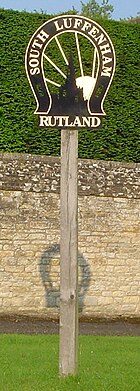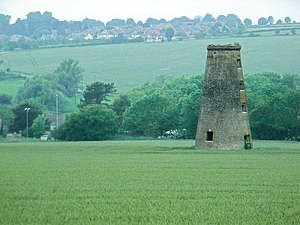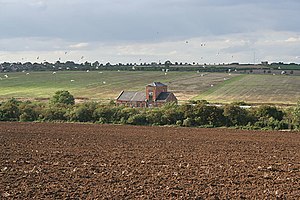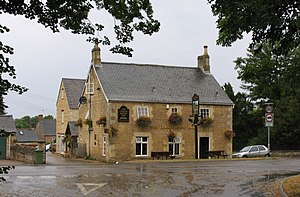South Luffenham
| South Luffenham | |
| Rutland | |
|---|---|
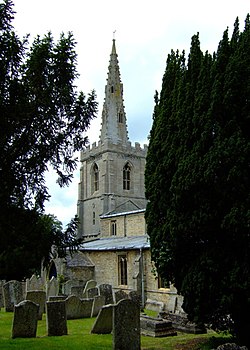 St Mary the Virgin | |
| Location | |
| Location: | 52°36’25"N, 0°36’40"W |
| Data | |
| Population: | 432 (2001[1]) |
| Post town: | Oakham |
| Postcode: | LE15 |
| Dialling code: | 01780 |
| Local Government | |
| Council: | Rutland |
| Parliamentary constituency: |
Rutland and Melton |
South Luffenham is a village and parish in the hundred of Wrandike, Rutland. The population of the civil parish at the 2001 census was 432, increasing to 455 at the 2011 census.[2]
The village lies largely on the north side of the A6121 road from Uppingham to Stamford in neighbouring Lincolnshire. It is divided into two by a small stream, the Foss, which is a tributary of the River Chater. South Luffenham Hall stands a short distance to the south-east of St Mary's church.
The village has two pubs, the Boot and Shoe and the Coach House (previously the Halfway House), as well as the Anglican church and the village hall. The post office closed in April 2006, but re-opened, on Monday afternoons only, in May of that year in the village hall. There is a ruined windmill near the outskirts of the village.
It once had a railway station that was located to the north of the village and also served the neighbouring village of North Luffenham. Luffenham railway station was opened in 1848 and closed in 1966. In fact there were two railway stations in the parish, since Morcott station lay just within the South Luffenham parish boundary.
Contents
History
Before World War II, the Earls of Ancaster had owned all the farms and most of the cottages, except Church Farm, which belonged to the Conants. The estate was then split up and sold off. In those early days, the village was self-sufficient, having two butchers and one baker. In addition, Bates' carrier journeyed from Barrowden each Friday to convey goods, but no passengers, to Stamford; cash would also be taken to the banks. Joe Kirby came from Barrowden each Saturday afternoon in a covered wagon selling haberdashery. The post came from Stamford by horse and cart, and subsequently by rail to Luffenham station, and whoever kept the village post office was obliged to take the letters round the village.
The last blacksmith was Mr Pepper from Barrowden who visited twice weekly until 1910. To the south of the smithy, in Back Lane in a shed, was a general grocers store.
In November 1904, as Edward Berridge of Ketton was delivering bread in South Luffenham, Charles Louth stole a loaf of bread to the value of 2½d, from the cart. He was sentenced to 14 days hard labour.
Out and about
Around the village are a number of old lanes little used now as they were of old. Cannonball Lane leads up to Morcott Spinney, so called because it is handed down that Cromwell's men set up his cannons in this spinney from which to fire on North Luffenham.
Shocky Balke (baulk meaning a strip of grass between cultivated strips) leads southwards from the top of Pinfold Lane on to the common, where there was a pond. From this point, the track became Hangman's Lane up to the gallows, sited there, it is said, to discourage the poor who would collect their wood and feed their geese on the common. The point is marked today by some fir trees.
The common originally stretched from Barrowden Lane to Fosters Bridge. The Earl of Ancaster exchanged his fields, on which the allotments and recreation field now stand, for the 400 acres of common on which he built Luffenham Heath golf course which opened in 1911.[3] In January 1921, fire destroyed the workshop, showroom, and caddy's hut at the Golf Cub, having been started by a spark from a stove in the workshop.
At Christmas 1793, a tribe of gypsies and their king were camping at the 'Follies' near Fosters Bridge. The gypsy king, named Edward Boswell, had a beautiful daughter, Rose, the Princess. She was just 17 and dying of consumption (tuberculosis). When the time came to move on, she was too ill to travel in a jolting caravan, and so the gypsies stayed a further two months on the cold bleak heath. When she died, the churchwardens of South Luffenham would not have her buried in the parish because she was not a Christian. The curate, the Rev. Bateman, finally over-ruled his parishioners and she was buried in the south aisle. A few weeks later, a marble slab arrived from London, and was placed over her remains, subscribed by the many gypsies who converged from afar to express sympathy with their king. The slab is still faintly discernible in the church:
“In memory of Rose Boswell, daughter of Edward and Sarah Boswell, who died February 19th, 1794, aged 17 years. What grief can vent this loss, or praises tell, how much, how good, how beautiful she fell.”
Of other road tracks, Clay Lane leads to the fields below the cemetery, and for those following the main road to Morcott, there used to be a footpath along the north side, but some years ago, the Council widened the road and absorbed the path. On the south side of this road stands a brick barn, this being built in Victorian times to serve as a dance hall for the two villages.
The village green was once surrounded with white posts and chains, with a seat in the middle. The fence was put up so that the children could play within without being disturbed by wandering cattle. The posts were removed in the 1930s.
In the 1920s, the Asphaltic Slag & Stone Co. Ltd set up a quarry and erected an office on the Stamford road, opposite the entrance to the recreation ground. Twenty men were employed but not from the village. The quarry business only lasted some four years as the stone was quarried out. Nothing survives as the site has been levelled.
In 1919, ironstone pits were opened on the road to Pilton; there were extensive sidings to service the pits, which closed in 1968.
Another quarry opened up at the north east of the parish and was served by a rail line connecting with the main line near Foster's Bridge. In October 1920, Arthur Waterfield was killed by a fall of earth while engaged at the Luffenham Ironstone Works.[4]
The Tunnels
Tunnels are said to run from the church to the Foss (the stream), and from the Old Hall site in Tailby's (now Bellamy's) field to the church. One villager recollects in 1912 going down the latter tunnel to rescue a terrier dog. The tunnel was some five feet high, ten feet down and built of rough stone. Having travelled five yards in the direction of the Hall he gave up and returned because of the crumbling condition of the tunnel walls.
There are various theories regarding the mounds in Tailby's field. Some recount that it is the site of the Old Hall and surrounding cottages, others think that the main mound covers an old icehouse. It is true that a few years ago a calf fell into a tunnel beneath the mound, and that afterward this was firmly covered over.
At the northern corner of this field is the Adam and Eve Barn, so called because of the inset stone carving. It is thought to have been an earlier tithe barn to that which now adjoins the church. Before the Great War, the building, also known as the old Primrose Barn (after the Primrose League used by them prior to 1900) served as the village hall, and dances were held there; here would be danced the 'Lancers' and 'down the middle', all to the accompaniment of an accordion. Later the old school room, opposite the new school, was used for village meetings, until the new village hall was built in September 1922. There was also, at the turn of the 20th century, a reading room and men's club in Sapcote Cottages.
The 'Old School', now a private cottage, was built in 1846 with pointed windows, to show its connection with the church. This first school was the National School, and it was not until 1875 that the new school opposite was built by the rector, Rev. James Lonsdale and presented to the village. He built it at his own expense and purchased the old school to house the head teacher. In 1900, there were 130 pupils; in 1969, when the school finally closed, there were 30. In 1972, the building was turned into a private house.
The War
There is no recollection of any bombs falling in the parish during the Second World War, or of aircraft crashes. War touched the community in the form of 28 child evacuees, who in 1940 arrived from London at the height of the bombing of that city. Among them was young Terry Parsons, later to become a famous singer, under the name of Matt Monro.
A pinfold was formerly sited at the south end of Pinfold Lane. It was constructed with a six-foot high stone wall with iron gates, and was finally knocked down in 1910, although a part of the wall still survives today. One villager recollects a farmer walking his sheep from Ayston to Stamford Market and resting them in the pinfold overnight.
The village did not have a public pond and cattle would drink from the ford on Back Lane, crossing for villagers being by footbridge. There was a pond on private land, where the last bungalow on North Luffenham Road is now sited. A bridge replaced the Back Lane ford in the 1940s.
A lead village pump on the north side of The Square was removed in the 1950s. The well underneath was fed from another well at the corner of Cutting Lane and Gatehouse Lane, the Council paying ten shillings a year to the LNW Railway for a pipe to run underneath the railway. The owner of the top well then demanded ten shillings a year. When the Council refused to pay, the supply was cut off. The Council then sank themselves a well in the Hempyards to supply The Square. The Hempyards, also known as the Ropewalk, survive as mounds today, but nothing is known of the actual works, and it is assumed that they closed in the mid 19th century or earlier.
The public water supply for the other half of the village came from the spring, still running today, and sited below the old grocer's shop opposite the Boot and Shoe.
Cattle were taken to be washed at the wash-dyke set in the Chater, just below the stone bridge on Moor Lane (North Luffenham Road). The wash-dyke was last used in 1925.
The Mills
The windmill was built in 1832;[5] in 1895, a storm blew the cap off, but the building continued to be used until 1908.
The watermill is early 19th century.[6] Owned by Molesworths, a miller was employed, who was responsible for controlling the water level of the sluice and the working of the mill. In addition, his duties covered management of the Railway Hotel. After the closure of the adjoining mill, trade at the hotel decreased and it was forced to close in the 1930s. Prior to 1910, flour had mainly been milled, and 16-stone sacks were hoisted to the second floor for storage and lowered to carts below when required. When the steam-driven mill was installed in 1910, the mill concentrated on offals; this consisted of split beans, split maize, kibbled wheat (lightly rolled for chickens) and barley meal. Gleaners from the fields took their grist at harvest to the mill to make barley meal for their home-fed pig. Wheat was frailed (flailed) at home with two long poles with leather thongs, this having to take place when there was a high wind, in order that the chaff should blow away. Some gleaners frailed with a five-pronged fork.
The watermill was sold in 1927. Mr Asplin, the miller, closed the sluice gate one night, forgot about it, and by morning the house and the mill were flooded. He continued milling offal until 1948, when the flume broke, the river taking a different course, and the mill was forced to close.
A steam and electric mill was built by Edmund Stapleton in 1890. The mill machinery was railed direct from Thomas Robinson & Son Ltd of Rochdale via a siding from the Midland Railway. The mill opened in 1892, Babcock & Wilcox steam boilers driving the rollers, and grinding grain at the rate of 8 sacks each of 20 stone per hour. Water for the boilers to make steam was pumped from the watermill. Production increased to 10 sacks per hour then 20. Twelve men were employed from the village, and six from other villages. Men from Molesworths quarry, when short of work, came to the mill, but spent more time in the Railway Inn. In 1914, men earned 14 shillings a week and by 1919, 27 shillings a week. The furthest delivery point by horse and cart was to Somerby, but in the 1920s Foden steam engines took over, these being replaced by Yorkshire cross-boiler engines with solid tyres. By 1925, a Dennis petrol wagon was hired from Leicester. This had pneumatic tyres and speeds of 30 mph were reached. Flour was then delivered as far away as Coventry and Spalding. Four tons would be carried on the wagon, and four on a trailer.
In the depression, Cadge & Colman purchased the milling rights, but the mill became uneconomic and the business was transferred to Godmanchester. Luffenham remained a distribution centre. In 1927, the works were closed. After remaining empty for some 13 years, Riull & Sons bought the premises and manufactured clips for rifle cartridges.
In 1942, the Ryvita Company installed a plant for drying and washing rye for biscuit manufacture, up to 20 men being employed at the peak season. The railway siding was in use at the time, but when the station closed in 1966, this link was severed and the factory closed. Newall Engineering then took the premises mainly for reconditioning of grinding machines, some 20 men being employed. The site is now Linecross Limited.
The Common
From the 14th century until Enclosure in 1882, owners of land held their strips, called 'known acres', each owner or occupier using the same strips each year as his own, subject to rights of grazing. An area of 1,074 acres was divided into 1,238 pieces among twenty-two owners.[7] When the crops had been gathered, the land became common pasture until wanted for the next cultivation. In South Luffenham, the tenants of the arable land alone had rights of common over the arable, whereas in Barrowden, owners of certain cottages had grazing rights. The ancient custom had been that a fixed or 'stinted' number of beasts used the fields, but of later years this was disregarded.
As the fog closed in on an elderly woman toiling up the common from Tixover, shrouded against the cold night air, the sound of the church bell tolling guided her back to South Luffenham. In gratitude, and for other who might become lost, she donated a field, whose income should pay the sexton to ring the bells at 5 am and 8 pm daily from the end of October to 25 March. This continued for many years until the outbreak of the Great War. The field was originally at Foster's Bridge, but the endowment was transferred to the Bellringers Field, also known as the Feast Field and Bell Field, opposite The Coach House.
The Rectors and other notable residents
Robert Cawdrey, compiler of one of the first dictionaries of the English language, the Table Alphabeticall, became rector in 1571 but was deprived in 1587 for his puritan sympathies.
Owen Gwyn, Master of St John's College, Cambridge from 1612 and Vice-Chancellor of the University of Cambridge 1615–16, was instituted Rector 28 October 1611, remaining in office until his death in 1633.
Robert Scott, (1811–1887) the co-editor with Henry George Liddell of a Greek-English Lexicon, the standard dictionary of Ancient Greek, was rector here for four years before he was elected Master of Balliol College, Oxford in 1854.[8] Balliol held the advowson from 1855 and many of the priests appointed were fellows of the college and noted scholars.
In 1867 promising 17-year-old poet Digby Mackworth Dolben drowned in the River Welland nearby when bathing with the son of his tutor, Rev. C. E. Prichard (1818–1869), rector of South Luffenham 1854–69.
Rev. James Lonsdale (Professor of Classics at King's College London and former Master of Hatfield College, Durham) was rector of South Luffenham 1870–73.[9]
George William Hudson Shaw (1859–1944) was Rector of South Luffenham from 1898 until 1907. As well as parson he was a famous travelling lecturer in the University Extension movement, and his work in adult education was recognised by the award of a fellowship of Balliol. Shaw also achieved success as a visiting lecturer in the United States, and during his time at South Luffenham he made three tours there. On his return from the last of these, in 1907, the boys of the village went down to the station to meet him and pulled a trap with him in it back to the rectory. The Rev. Hudson Shaw gave some of the fees he earned in America towards installing a new organ in the church; he also helped to raise funds to restore Sapcote (charity) Cottages, originally built as almshouses in 1857. He insisted that parishioners 'walked the bounds' to keep the footpaths open on each Rogation Day.
In 1901 Shaw met a young woman called Agnes Maude Royden, who was seeking a vocation. He brought her to live at South Luffenham rectory in 1902, and she worked in the village for a time as a parish assistant. Subsequently he supported her work as a public speaker, suffrage campaigner, and 'woman preacher'. She was an advocate of the ordination of women, and Shaw later caused controversy by allowing her to speak from his pulpit when he was rector of St Botolph-without-Bishopsgate in the City of London. In 1944 after the death of his wife, Hudson Shaw (at the age of 84) married Maude Royden; she told the story of their long and unusual relationship in a book called A Threefold Cord, published in 1947.
William Stephen Raikes Hodson (1821–1858), a soldier, "Hodson of Hodson's Horse", prominent in the Indian Mutiny, is commemorated here along with his father Rev. George Hodson, who was rector.
The Inns
Various businesses have been conducted at the Boot and Shoe Inn, a shoemakers business in the mid 19th century, which ceased around 1900, giving the inn its name. A coal business was also carried on from the inn, and the village bakehouse was on the west corner of the building, Mr Chard being the last baker until the 1950s. Villagers brought joints of meat and batter for Yorkshire puddings here on Sundays, and these were cooked in the bake oven for twopence a time up until 1935. The chamber for the flour for bread-making was sited above the ovens to keep it warm and dry, and 10-stone bags of flour from Luffenham Mills were hauled up on a wooden ladder.
The Halfway House inn was so called as it was an ostler house at the midpoint for stages. In 1814, the 'Lord Wellington Accommodation Coach' ran from Birmingham via Leicester and through South Luffenham at 10 am daily and connected at Stamford with the 'Lord Welling Coach' for travellers on to Norwich. The 'Leicester Coach' passed through at 3 pm on Mondays, Wednesdays, and Fridays from Stamford. The pub was extended and renamed the Coach House in the 1990s.
The former post office was once two cottages; in the part that was later the shop lived George Hippey, a platelayer. He fell foul of the landlord and one day threw paraffin under the front door, hastily followed by a lighted match.
References
| ("Wikimedia Commons" has material about South Luffenham) |
- ↑ "Rutland Civil Parish Populations" (PDF). Rutland Council. 2001. http://www.rutland.gov.uk/ppimageupload/Image27657.PDF. Retrieved 21 March 2009.
- ↑ "Civil Parish population 2011". Neighbourhood Statistics. Office for National Statistics. http://www.neighbourhood.statistics.gov.uk/dissemination/LeadKeyFigures.do?a=7&b=11128688&c=South+Luffenham&d=16&e=62&g=6384765&i=1001x1003x1032x1004&m=0&r=1&s=1466936404625&enc=1. Retrieved 26 June 2016.
- ↑ Article on Golf Club in Rutland Living magazine; Nov 2010
- ↑ Grantham Journal 23 October 1920
- ↑ Grade II listed building; List entry Number: 1361478
- ↑ Grade II listed building; List entry Number: 1295153
- ↑ A Short History of English Agriculture (1909) by W. H. R. Curtler
- ↑ Dictionary of National Biography, : Scott, Robert (1811-1877)
- ↑ A memoir of the Rev. James Lonsdale, late fellow and tutor of Balliol College, Oxford by Russell Duckworth (1893)
